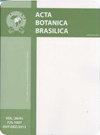标题茄科植物种复合体研究综述
IF 1.1
4区 生物学
Q4 PLANT SCIENCES
引用次数: 1
摘要
本文章由计算机程序翻译,如有差异,请以英文原文为准。
An overview on studies of species complexes in Solanaceae
Solanaceae comprises many species complexes, taxonomically challenging lineages that require specialized effort to be reliably delimited, and thus develop a reasoned hypothesis at the species level. To obtain an overview of aspects that permeate species complexes studies in Solanaceae, we collected and summarized details of selected works, resulting in 83 published articles comprising nine genera. Solanum , the most studied genus, spans all explored biogeographic realms, characterized by taxonomic complexity related to its long history of domestication. Capsicum is a unique case due to the adoption of complexes as an indicator of gene pool, while Petunia can potentially serve as a model for the use of species complexes to improve evolutionary knowledge given their phylogeographic studies. The Neotropical region concentrates the majority of research and presents the highest number of genera studied. Morphometrics is the main applied approach probably due to its low cost, followed by population genetics, reproductive biology, phylogeny, and others. Most studies do not present taxonomic decisions or apply integrated methods. We encourage studies with some neglected genera that may have hidden species complexes; a major effort to resolve the Solanum nigrum complex; and the use of effective, less applied fields of study such as ecology and
求助全文
通过发布文献求助,成功后即可免费获取论文全文。
去求助
来源期刊

Acta Botanica Brasilica
PLANT SCIENCES-
CiteScore
2.30
自引率
9.10%
发文量
32
审稿时长
6-12 weeks
期刊介绍:
Experimental, theoretical and applied papers on all aspects of plant (including algae) and fungi biology are welcome. The submitted manuscript or its essential content must not have been published previously or be under consideration for publication elsewhere. Contributions should be substantial, written in high-quality English and show general interest. We expect that the submitted manuscript presents a great novelty in Botany, and this should attract a wide audience. Considering this, case studies are only considered if the narrative and implications are provided to be of general interest. Thus, manuscripts that report aspects of local interest are discouraged unless the implications of the findings are wide-reaching. Manuscripts with agronomic subjects are expected to contain a substantial amount of basic plant biology. Please see below some details for specific area.
 求助内容:
求助内容: 应助结果提醒方式:
应助结果提醒方式:


